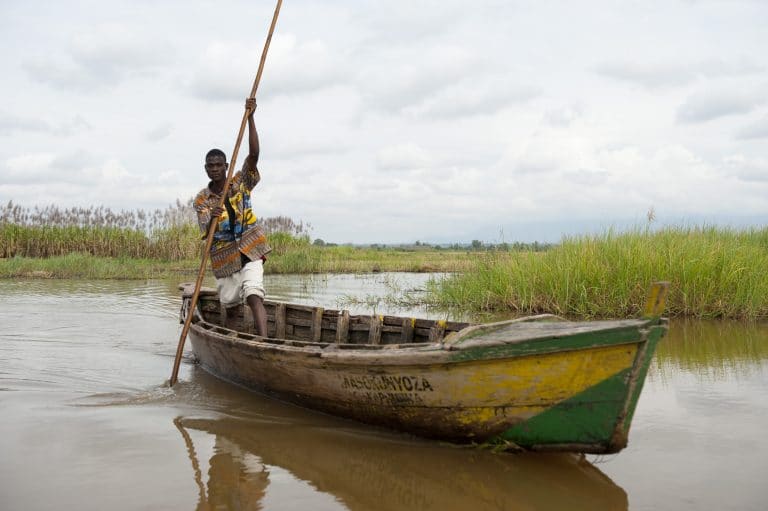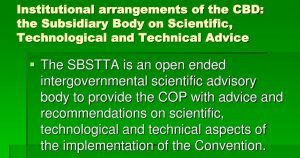Is the notion of sustainable use of biodiversity a legal principle of international law?
by Prof Ademola Oluborode Jegede in collaboration with Lesle Jansen
Sustainable use is a functional concept to mediate the tension between human being survival and the need for conservation of biodiversity. While the notion is often mentioned here and there in project cycles, it is sometimes unreflectively used or disregarded by policy and decision makers while making decisions on biodiversity in international life. In other words, the extent to which the concept qualifies as a binding legal principle is often scantily considered let alone properly appreciated by decision and policy makers in the environmental law field. Consequently, if I may mention from the onset, the purpose of this contribution is to demonstrate how the concept of sustainable use meets the criteria required of a legal principle. If I may further state at once, to achieve the purpose of this enquiry, it will be necessary to understand what is meant by a legal principle before proceeding to reveal why sustainable use is a legal principle.
The meanings of the word principle include “a fundamental truth from which others are derived, or on which others are founded; a maxim; an axiom; a postulate; the collectivity of moral or ethical standards or judgments; a settled rule of action; a governing law of conduct; the collectivity of moral or ethical standards or judgments.”[1] Against that background, legal principles refer to a prevailing standard, or better still, a prevailing standard on which particular norms and a body of practices are based.[2] Raz explains the basic sources of legal principles and their legal effect. In his view, legislation and case law are the primary sources of legal principles and their collective effect is that, unless repealed, they become legally binding through establishment by the courts. A legal principle does not become established through case law just by a single judgment; though. It evolves rather like a custom and becomes binding only if it attracts a commanding support in a line of judgments.[3]

Coconut farming, Pangan, Tanzania
Sustainable use forms a core part of UN CBD objectives
When viewed in the context of the provisions of International instruments that are the equivalence of legislation in international system and emerging case law, it is not difficult to establish that the concept of sustainable use qualifies as a legal principle of international law. Sustainable use forms a core part of the three objectives of theUN CBD – the conservation of biological diversity, the sustainable use of its components, and the fair and equitable sharing of the benefits from the use of genetic resources – that are mutually supportive and stand on equal footing.[4] In particular, to validate its relevance to biodiversity, article 2 of the UN CBD defines sustainable use as:
The use of components of biological diversity in a way and at a rate that does not lead to the long-term decline of biological diversity, thereby maintaining its potential to meet the needs and aspirations of present and future generations.[5]
The concept is further supported by the preamble of the Nagoya Protocol on Access to Genetic Resources and the Fair and Equitable Sharing of Benefits Arising from their Utilisation to the UN Convention on Biological Diversity. Nagoya which highlights the interrelationship between genetic resources and traditional knowledge, their inseparable nature for indigenous and local communities, and the importance of the traditional knowledge for the conservation of biological diversity and the sustainable use of its components, for the sustainable livelihoods of these communities.[6] Sustainable use is also a subject of focus in a number of the COP Decisions which further explicate the relevance of the notion to biodiversity. In addition to Decision VI/13 which is devoted to the concept,[7] Decision V/24 highlights sustainable use as a cross-cutting issue,[8] while Decision VIII/21 focuses conservation and sustainable use of deep seabed genetic resources beyond the limits of national jurisdiction,[9]

Seaweed farming, Zanzibar, Tanzania
Human rights, sustainable use and the rights to subsistence
The notion of sustainable use is stressed in other relevant provisions of existing key environmental instruments outside the CBD: Convention on the Conservation of Migratory Species of Wild Animals (CMS)[10] and CITES (Convention on International Trade in Endangered Species of Wild Fauna and Flora)[11]; the United Nations Convention to Combat Desertification in Those Countries Experiencing Serious Drought and/or Desertification, Particularly in Africa)[12], the United Nations Framework Convention on Climate Change[13] and the Paris Agreement thereunder[14] – and the Convention on Wetlands of International Importance especially as Waterfowl Habitat (the “Ramsar Convention”),[15] the United Nations Convention of the Law of the Sea,[16] and the 2030 Agenda for Sustainable Development.[17] At the regional level in Africa, a fundamental objective of the African Convention on the Conservation of Nature and Natural Resources is to foster the conservation and sustainable use of natural resources.[18] Also, sustainable use is a key component of the Aspiration 1 dealing with inclusive growth and sustainable development under the African Union Agenda 2063.[19]
Besides, sustainable use is a core aspect of right to subsistence as envisaged in the provisions of key international human rights instruments. For instance, article 25 of the Universal Declaration of Human Rights includes the right to subsistence in affirming that “everyone has the right to a standard of living adequate for the health and well‐being of himself and of his family, including food, clothing, housing and medical care and necessary social services, and the right to security in the event of unemployment, sickness, disability, widowhood, old age or other lack of livelihood in circumstances beyond his control” [20] In particular, article 1(2) of the International Covenant on Civil and Political Rights (ICCPR) equally provides:
All peoples may, for their own ends, freely dispose of their natural wealth and resources without prejudice to any obligations arising out of international economic co-operation, based upon the principle of mutual benefit, and international law. In no case may a people be deprived of its own means of subsistence
Therefore, as far as state parties to the conventions listed above are concerned, the notion of sustainable use as incorporated in the instruments is binding as a legal principle to be considered in all relevant actions for realising the provisions in the instruments.
Aside from the foregoing, best practices relating to accountability for sustainable use abounds globally. With particular reference to the African Continent, under the African regional human rights system, in Centre for Minority Rights Development (Kenya) and Minority Rights Group (on behalf of Endorois Welfare Council, the environmental and cultural significance of the subsistence use of land by indigenous peoples was part of the focus in the analysis of the African Commission on Human and Peoples’ Rights (the Commission).[21] In that case the complainants argue that the creation of a game reserve on their land is in disregard of national law, Kenyan constitutional provisions and, most importantly, certain articles of the African Charter, including the rights to property, free disposition of natural resources, religion and cultural life.[22] The Endorois community emphasised that access to their land is crucial to the securing of their subsistence and livelihood and it is inseparably linked to their cultural integrity and traditional lifestyle.[23] This cultural lifestyle embodies, the community further explains, a close intimacy with ‘grazing lands, sacred religious sites and plants used for traditional medicine’, all situated around the shores of Lake Bogoria.[24]
In arriving at its decision, the Commission reviewed its decision in the Ogoniland case,[25] and reiterated the approach in the earlier jurisprudence of the Inter-American system in the matter of Awas Tingni.[26] Based on these decisions, the Commission took the position that to indigenous communities, relations to the land are not merely a matter of possession and production but a material and spiritual element which they must fully enjoy, even to preserve their cultural legacy and transmit it to future generations.[27] It then found that the Kenyan government had violated the Endorois‘ rights to religious practice, to property, to culture, to the free disposition of natural resources, and to development, under the African Charter (Articles 8, 14, 17, 21 and 22, respectively).[28]

Fishing in Lake Chilwa, Malawi
Conclusion
In conclusion, as has been shown, in so far as legislation and case law constitute the basis of a legal principle, the notion of sustainable use is a legal principle recognised under international law. It is hoped that decision makers and project developers as well as policy makers who are daily engaged in finding, affirming, deciding, forecasting, directing and ensuring compliance with all obligations and commitments regarding biodiversity will not ignore but apply the notion even more reflectively.
References
[1] ‘Principle’ <https://www.wordnik.com/words/principle> accessed 10 June 2021; also see J. Daci Legal Principles, Legal Values and Legal Norms: are they the same or different? Academicus – International Scientific Journal 109
[2] As cited by JR Muniz “Legal Principles and Legal Theory”. Ratio Juris. Vol. 10 No. 3 September 1997 (267–87).
[3] J Raz Legal Principles and the Limits of Law The Yale Law Journal Vol. 81: 823, 1972
[4] The Convention on Biological Diversity of 5 June 1992 (1760 U.N.T.S. 69);
[5] CBD (n 4 above) art 2
[6] Nagoya Protocol on Access to Genetic Resources and the Fair and Equitable Sharing of Benefits Arising from their Utilisation to the Convention on Biological Diversity, Doc.: UNEP/CBD/COP/DEC/X/1 of 29 October 2010, preamble
[7] www.cbd.int/decision/cop/?id=7187
[8] www.cbd.int/decision/cop/?id=7166
[9] www.cbd.int/decision/cop/?id=11035
[10] Convention on the Conservation of Migratory Species of Wild Animals UNTS Volume Number: 1651, preamble
[11] Convention on international trade in endangered species of wild fauna and flora UNTC Volume Number 14537 which calls for the protection of the flora and fauna for the present and future generation
[12] United Nations Convention to Combat Desertification in those Countries Experiencing Serious Drought and/or Desertification, Particularly in Africa United Nations, Treaty Series , vol. 1954, p. 3, article 19(1)(c) which seeks to empower capacity building of States for the conservation and sustainable use of natural resources;
[13] United Nations Framework Convention on Climate Change (UNFCCC) (1992) ILM 851; Art 3(4) on the recognition of sustainable development and 3(5) on sustainable economic growth in State parties especially developing states
[14] Paris Agreement under the United Nations Framework Convention on Climate Change, adopted 30 Nov.- 11 Dec. 2015 at the 21st Session, Conference of the Parties, fccc/cp/2015/L.9/Rev.1 (Paris Agreement 2015).Preamble on equitable access to sustainable development, sustainable lifestyle and sustainable consumption while article 6 generally deals with sustainable development
[15] Convention on wetlands of international importance especially as waterfowl habitat UNTS Volume Number 14583, art 3(1) on the wise use of wetlands
[16] Convention on the Law of the Sea, Dec. 10, 1982, 1833 U.N.T.S. 397, art 119(1)(a) on the need for States to maintain or restore populations of harvested species at levels which can produce the maximum sustainable yield
[17] United Nations General Assembly Transforming our World: the 2030 Agenda for Sustainable
Development, A/res/70/1, adopted by the General Assembly on 25 Sep. 2015
[18] Revised African Convention on the Conservation of Nature and Natural Resources. Share: Date of Adoption: March 07, 2017
[19] Agenda 2063 Final Edition, April 2015 The Africa We Want Para 18
[20] United Nations. Universal declaration of human rights (UDHR). (1948). https://www.un.org/en/documents/udhr/
[21] Communication 276/03, Centre for Minority Rights Development (Kenya) and Minority Rights Group (on behalf of Endorois Welfare Council) (Endorois case) 27th Activity Report: June- November 2009, 237
[22] Endorois case (n 19 above) para 21
[23] Endorois case (n 19 above) para 16
[24] As above
[25] Communication 155/96, Social and Economic Rights Action Center (SERAC) and Center for Economic and Social Rights (CESR) v Nigeria 15th Activity Report: 2001-2002 (Ogoniland case)
[26] Mayagna (Sumo) Awas Tingni Community v Nicaragua, Inter-American Court of Human Rights 31 August 2001 (Awas Tingni case);
[27] Awas Tingni case (n 24 above) paras 148-149
[28] African (Banjul) Charter on Human and Peoples’ Rights, adopted 27 June 1981, OAU Doc. CAB/LEG/67/3 rev. 5, 21 I.L.M. 58 (1982), entered into force 21 October 1986



